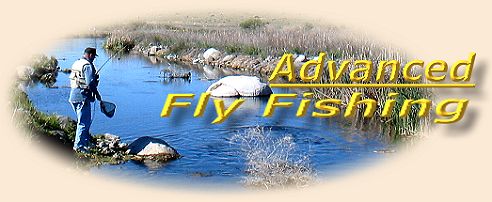|
As simple as it may seem, the way you tie on your fly can
catch you more fish. Being a fly fishing guide for more
than 25 years, I have learned that outstanding nymph
fishermen use small and successful tricks or finesses to
gain the edge on the average Joe. The small finesses are
the little tricks that induce the extra strikes when the
fishing is poor and the better strikes when the fishing
is good. From rigging their leaders and tippets to the
slightest variance in their cast are often the difference
that transforms the day of fishing from marginal to great.
I have several of these little tricks that often make the
day for myself or my clients. One in particular is the
knot that I use to tie on my nymph. Believe it or not,
something as simple as a knot can make a difference in
presentation and whether an elusive 24 inch Brown takes
or ignores the morsel that you are presenting. While
tippet size, leader length, fly line weight and several
other factors can also influence your prey, the knot is
the part of your rigging that is the closest to the fish
and its' effect is most visible.
Most nymphs are tied on Turned-Down-Eye (TDE) hooks --- why?
Can anyone provide an advantage for using a TDE hook when
nymph fishing? I don't care what shank length or size it is
they all share the same disadvantage, the Turned-Down-Eye.
Actually I believe the TDE hooks were made for snelling,
tying the line on the hook by wrapping it around the hook
shank and then out the hook-eye. TDE hooks actually favor
the dry fly angler more than the nymph fisherman. For the
dry fly angler, the angle of the hook-eye lets the tippet
dangle to the water without tipping the fly over forward.
While for the nymph fisherman the TDE hook lessens the hook
gape and inverts the nymph making it drift up-side-down.
The inversion of the fly would not be such a disadvantage
if it kept the fly inverted at all times and stopped snagging
with the bottom. Then the tyer could tie the back of the fly
in the gape side or hook's belly instead of on the hook's back
and make the pattern's appearance upright at all times. This
is particularly true if the fly is imitating a swimming nymph,
because a swimming nymph always rights itself before swimming
away. Large predator nymphs like Stoneflies and Dobson flies
are examples of this.
Well, are Straight-Eyed hooks or Turned-Up-Eyed (TUE) hooks
any better? Knot really. That was not a misspelling but a
pun to make a point. The knot really makes the difference
no matter what type of hook you are using. If you tie the
nymph on with just about any conventional or traditional knot
when dead-drifting the pattern and the nymph is not touching
the bottom, it drifts dangling straight down or vertically
below the line or indicator. This may be a normal presentation
for some nymphs like ---- I can't think of one. Well you might
say an emerging nymph, but emerging nymphs are swimming up toward
the surface not floating vertically a couple of feet below the
surface. Sorry, in my rivers nothing floats vertically several
feet below the surface. I don't think they do in yours either.
But if the knot actually determined your nymph's position
regardless of the style of hook it would be an enormous advantage
for the angler. This is possible. Here are your choices:
Guaranteed Vertical; Guaranteed Horizontal with the hook-point-down;
and Guaranteed Horizontal with the hook-point-up. Which would you
- the angler - choose? Well truthfully there is, or could be, a
time and presentation for each of these hook positions. Guaranteed
Vertical is used for emerging nymphs, but don't dead drift them.
Swim them to the surface. Guaranteed Horizontal with the
hook-point-down would best be used in deep water when there is
not a chance of coming in contact with the bottom. And lastly,
Guaranteed Horizontal with the hook-point-up is the best choice
for most fishing situations.
Why is Guaranteed Horizontal with the hook-point-up the best
choice? Most true aquatic and pseudo aquatic nymphs move through
the water in a horizontal position. From Oligochaete worms to
minnows, horizontal is the normal presentation. The hook-point-up
is the best choice if the bottom is barely a possibility. Snagging
the fly on the bottom loses it or dulls it. Also, hook-point-up
hooks the fish in the stouter portion of its mouth; the upper jaw.
Hooking the fish here gives the angler more leverage and lift on
the fish during the fight. Ever wonder why carp don't come to
the surface easily? Their tail is almost always above their mouth
during a fight.
So what is this wonderful knot that I use to guarantee the hook
position of a nymph? Believe it or knot, it is any slip knot
that you tie best. It could be a "Universal Knot" or a "Clinch
Knot" or any other knot that lets the tippet slip through the
middle of it to tighten. You see it is not the knot - but the
relationship of the hook-eye, the tippet, and where you place
the knot on the hook that makes all the difference in the world.
Guaranteed Vertical
Let's take the simplest presentation first - Guaranteed Vertical.
With a Straight-Eyed, TUE, or TDE hook tie the fly on using any
knot that tightens on the hook-eye. The pictures below are all
#12 Sowbug tied on different style hooks. All three bugs have
the same amount of lead wire, 10 wraps of .025, straw backing,
thread, and dubbing. The pictures are, from left to right, a
Straight-Eyed hook, a TUE hook, and a TDE hook.

This is most likely the way that ninety-nine percent of the
fishermen tie on their nymphs with some sort of knot tightening
on the front of the hook-eye.
Guaranteed Horizontal with the Hook-point-down
The next two presentations are a little more difficult depending
on the hook the nymph is tied on. So let's try Guaranteed Horizontal
with the Hook-Point-Down. We are tying on a Straight-Eyed hook or a
TUE hook. Using either style hook the tying method is the same.
Put the tippet through the hook-eye on the hook's back side going
down to the hook's belly side. Again this is important, the tippet
through the back side of the hook. Tie a slip knot on the end of
the tippet. Run the nymph through the loop of the slip knot tail
first. Position the loop of the slip knot between the head of
the nymph and the hook-eye (on the fly's head threads). Tighten
the slip knot at this position on the hook with the knot of the
slip knot on the hook's belly side. Pull the slack out of the
tippet up through the hook-eye.
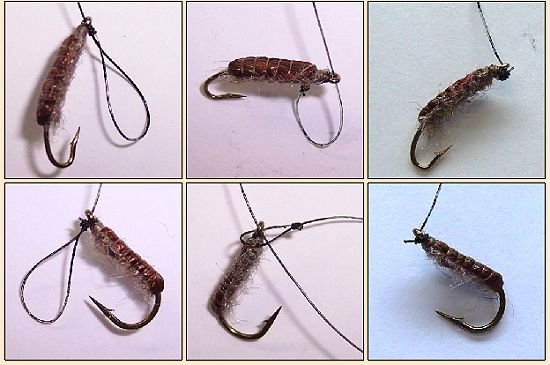
That makes these two styles of hooks, Straight-Eyed and TUE
Guaranteed Horizontal with the Hook-Point-Down. Now, what
about the TDE hook?
Again run the tippet through the back side of the hook-eye going
down to the belly side. Again tie a slip knot on the end of the
tippet. This time, run the nymph through the loop of the slip
knot head first, I repeat head first. Position the loop between
the hook-eye and the head of the nymph (on the fly's head thread).
If you have this correctly positioned the tippet should be under
the loop. Tighten the slip knot with the knot of the slip knot
on the hook's belly. Pull the slack out of the tippet back through
the hook-eye. This is Guaranteed Horizontal with the Hook-Point-Down
for the TDE hook style.
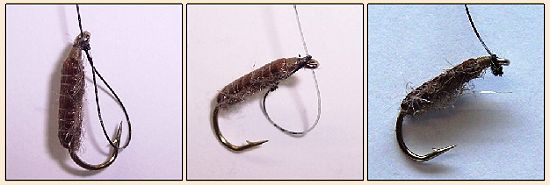
Guaranteed Horizontal with the hook-point-up
Last presentation, Guaranteed Horizontal with the Hook-Point-Up.
Well if you made it through "horizontal with hook-point-down,"
this presentation won't be to hard to understand. Let's start
with the simplest hook style the TDE hook. Run the tippet through
the belly side of the hook-eye going to the back (this is opposite
of the "horizontal hook-point-down" presentation). Tie a slip knot
at the end of the tippet. Now depending upon the size of wire the
hook is made of: if it is a thin wire hook like a dry fly hook
(which I tie all my nymphs on) run the tail of the fly through
the loop of the slip knot; if it is a heavy wire hook run the
hook-eye through the loop of the slip knot. In both cases
position the loop of the slip knot between the head of the fly
and the hook-eye and tighten the slip knot with the knot of the
slip knot on the back side of the hook. Then pull the slack out
of the tippet from the belly side of the hook. If you tied it
correctly, on the thin wire hook the slip knot is between the
hook-eye and the head of the nymph. The tippet is in front of
the slip knot coming through the hook-eye. For the heavy wire
hook the loop tightens at the same position but on top of the
tippet. The Straight-Eyed hook is tied in the same manner
depending upon the weight of the fly. For light flies the slip
knot tightens behind the tippet, for heavy flies the slip knot
tightens over the tippet.
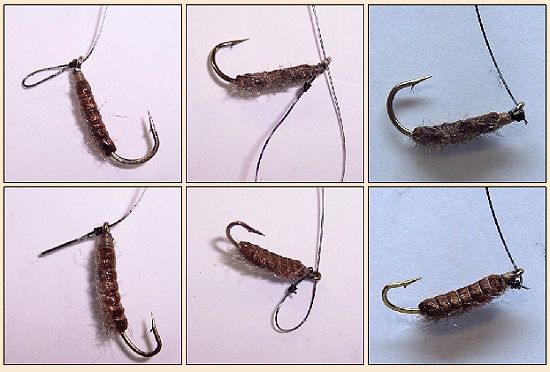
For the TUE hook there is only one choice for tying "horizontal
hook-point-up." Put the tippet through the belly side of the hook.
Tie a slip knot on the end of the tippet. Run the hook-eye through
the loop of the slip knot. Position the loop of the slip knot
between the hook-eye and the head of the nymph. Tighten from the
back side of the hook. Pull the slack of the tippet back through
the belly side of the hook-eye. If tied correctly the slip knot
loop is over the tippet.
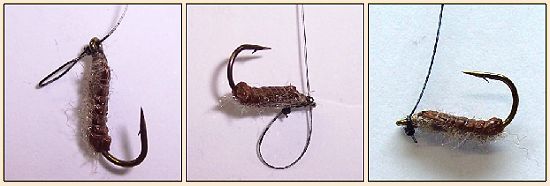
Questions & Answers
Have you asked yourself whether or not this could make a difference
in other types of fishing: soft-hackles, streamers, maybe dry flys?
Let's just say it depends on how you are presenting them. Are you
fishing them like a nymph? Then yes it does.
Which style of the three hooks (Straight-Eyed, TUE, and TDE) do you
think I choose for my nymphs? My preference is Straight-Eyed dry fly
hooks. The hook-gape is not lessened by the eye of the hook and the
light wire penetrates the flesh and bone of the fish with less force.
Which is essential when your tippet is 6X and smaller.
Do I tie my nymph's back on the hook's belly. No I don't, who would
buy them that way? But I do give them a half twist on the hook after
I tie them on my tippet.
I tie my jigs on different also but that's another article as well.
Rare is the nymph fisherman that will take the time to be this
meticulous when tying on his/her nymph. But -- I am a rare nymph
fisherman and my reputation is a testament of its worth. ~ FS
|
